

Stakeholder Circle Methodology. The Stakeholder Circle® has been designed to put stakeholders on the ‘project management radar’.
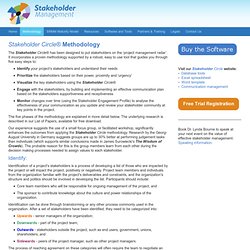
It incorporates a proven methodology supported by a robust, easy to use tool that guides you through five easy steps to: Identify your project’s stakeholders and understand their needsPrioritize the stakeholders based on their power, proximity and ‘urgency’Visualize the key stakeholders using the Stakeholder Circle®Engage with the stakeholders, by building and implementing an effective communication plan based on the stakeholders supportiveness and receptivenessMonitor changes over time (using the Stakeholder Engagement Profile) to analyse the effectiveness of your communication as you update and review your stakeholder community at key points in the project.
The five phases of the methodology are explained in more detail below. The underlying research is described in our List of Papers, available for free download. Identify: Prioritize: Visualize: Stakeholder Management from the perspective of Sun Tzu Project Accelerator News. Sun Tzu wrote The Art of War nearly 2500 years ago; his ideas have been widely translated and are regularly used as a guide for management thinking.
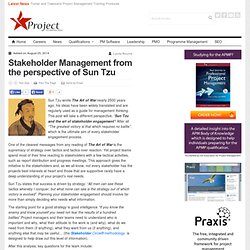
This post will take a different perspective, ‘Sun Tzu and the art of stakeholder engagement’! After all “The greatest victory is that which requires no battle”, which is the ultimate aim of every stakeholder engagement process. One of the clearest messages from any reading of The Art of War is the supremacy of strategy over tactics and tactics over reaction. Yet project teams spend most of their time reacting to stakeholders with a few tactical activities, such as report distribution and progress meetings.
This approach gives the initiative to the stakeholders and, as we all know, not every stakeholder has the projects best interests at heart and those that are supportive rarely have a deep understanding of your project’s real needs. After this analysis, key questions for the team include: How reliable is our information? Agile, Scrum and other resources. Functional Testing with Selenium — Zurmo. Selenium is an open source software used for automating web applications for testing purposes.
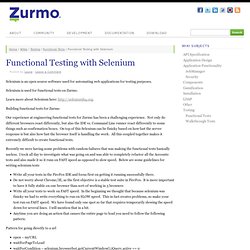
Selenium is used for functional tests on Zurmo. Learn more about Selenium here: Building functional tests for Zurmo Our experience at engineering functional tests for Zurmo has been a challenging experience. Not only do different browsers react differently, but also the IDE vs. Recently we were having some problems with random failures that was making the functional tests basically useless. Write all your tests in the FireFox IDE and focus first on getting it running successfully there.Do not worry about Chrome/IE, as the first objective is a stable test suite in FireFox. Pattern for going directly to a url open – myURLwaitForPageToLoadwaitForCondition – selenium.browserbot.getCurrentWindow().jQuery.active == 0. 10 Reasons Why You Should Use GUI Test Tools. Several testing tools have been developed in the bid to enhance software quality and reduce software development time.
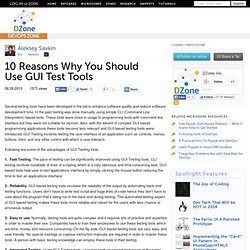
In the past testing was done manually using simple CLI (Command Line Interpreters) based tools. These tools were close in usage to programming tools with command line interface but they were not suitable for layman. Also, with the advent of complex GUI based programming applications these tools become less relevant and GUI based testing tools were introduced.
GUI Testing involves testing the user interface of an application such as controls, menus, buttons, links, and any other control with which a user interacts. The Testing Industry's Automated Testing Tool Conundrum – and the Proposed Solution - Software Test Professionals - Testing, Quality Assurance, and People. Most currently available automated software testing tools are platform-, technology- and/or operating system dependent.
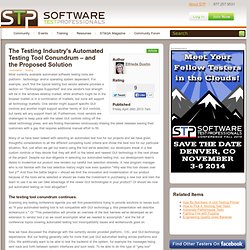
For example, you'll find the typical testing tool vendor website provides a section on "Technologies Supported" and one vendor's tool strength will be in the windows desktop market, while another's might be in the browser market or in a combination of markets, but none will support all technology markets. One vendor might support specific GUI controls and another might support another family of GUI controls, but rarely will any support them all. Furthermore, most vendors are challenged to keep pace with the latest GUI controls rolling off the latest technology press, and are finding themselves continuously chasing the latest releases leaving their customers with a gap that requires additional manual effort to fill. Maintainable Automated UI Tests.
A few years ago I was very skeptical about automated UI testing and this skepticism was born out of a few failed attempts.
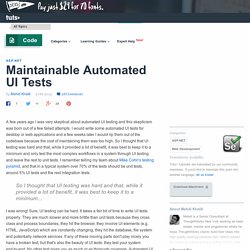
I would write some automated UI tests for desktop or web applications and a few weeks later I would rip them out of the codebase because the cost of maintaining them was too high. Things to Keep in Mind While Working With Telerik Test Studio VS Plugin. Hi Friends, Lately, I have been working on automating the test cases for our Silverlight Applications.

After trying what is available out there, I can easily vouch for Telerik Test Studio. It's the most advanced Test Automation tool available out there for Silverlight Applications. Telerik Test Studio comes with a VS plugin that allows you to do nearly everything that is possible via its standalone product. However there are a few points that I found, we need to keep in mind to make the best out of it. This will help save you many run time errors that are very difficult to spot otherwise. 2. This is another painful area of VS extensions of Telerik test Studio. For example: suppose I have a test case named "Create New Company" the underlying class name will be something like "ProjectName.Foldername.Create_New_Company". 3.
Silverlight loves rendering the UI only as much as it needs to display per view port. Create Your First Successful Test Studio Project.